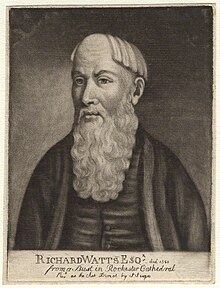Richard Watts
| Richard Watts | |
|---|---|
 |
|
| Born | 1529 |
| Died | September 10, 1579 |
| Resting place |
Rochester Cathedral 51°23′20″N 0°30′12″E / 51.388962°N 0.503293°E |
| Citizenship | English |
| Occupation | Businessman, MP |
| Years active | 1536–1571 |
| Known for | Philanthropy |
| Notable work | Richard Watts Charity |
| Board member of | Rochester Bridge Trust |
Richard Watts (1529–1579) was a successful businessman and MP for Rochester, South East England, in the 1570s. He supplied rations for the English Navy as deputy victualler and supervised the construction of Upnor Castle. After Queen Elizabeth I pronounced his house was "satis" (Latin for enough) after a visit in 1573, the house was thereafter known as Satis House. Famed locally for his philanthropy, he died on 10 September 1579, leaving money in his will to establish the Richard Watts Charity and Six Poor Travellers House in Rochester High Street. He is buried, in accordance with his will, in Rochester Cathedral.
The precise date and place of Richard's birth is uncertain. A Richard Watts born in West Peckham in 1529 is believed to be Richard Watts of Rochester. However, there is evidence of an older Richard Watts living on Boley Hill, at a date during the supposed childhood of the Richard Watts born in West Peckham. Little is known of the early life of Richard Watts. He may have spent his youth in Rochester gaining employment with Bishop (later Saint) John Fisher. Following the arrest and execution of Fisher, Watts returned to Rochester in a state of poverty.
By 1550, Richard Watts was established as a merchant. Payments were made to him for victualling the army and navy in 1550 and 1551. In either 1552 (Lane & Singh) or 1554 (Hinkley) he was appointed deputy victualler of the navy. The earlier date fits in with the grant of a coat of arms in 1553. In 1559, he was reappointed to the post. Subsequently, Queen Elizabeth I appointed him as paymaster and surveyor of works when building of Upnor Castle started in 1560. A further royal appointment, that of surveyor of ordnance, followed in 1562. In 1560, as well as his appointment to the castle, he became paymaster to the Wardens of Rochester Bridge. In 1563, he was elected as MP for Rochester which seat he held until 1571.
...
Wikipedia
